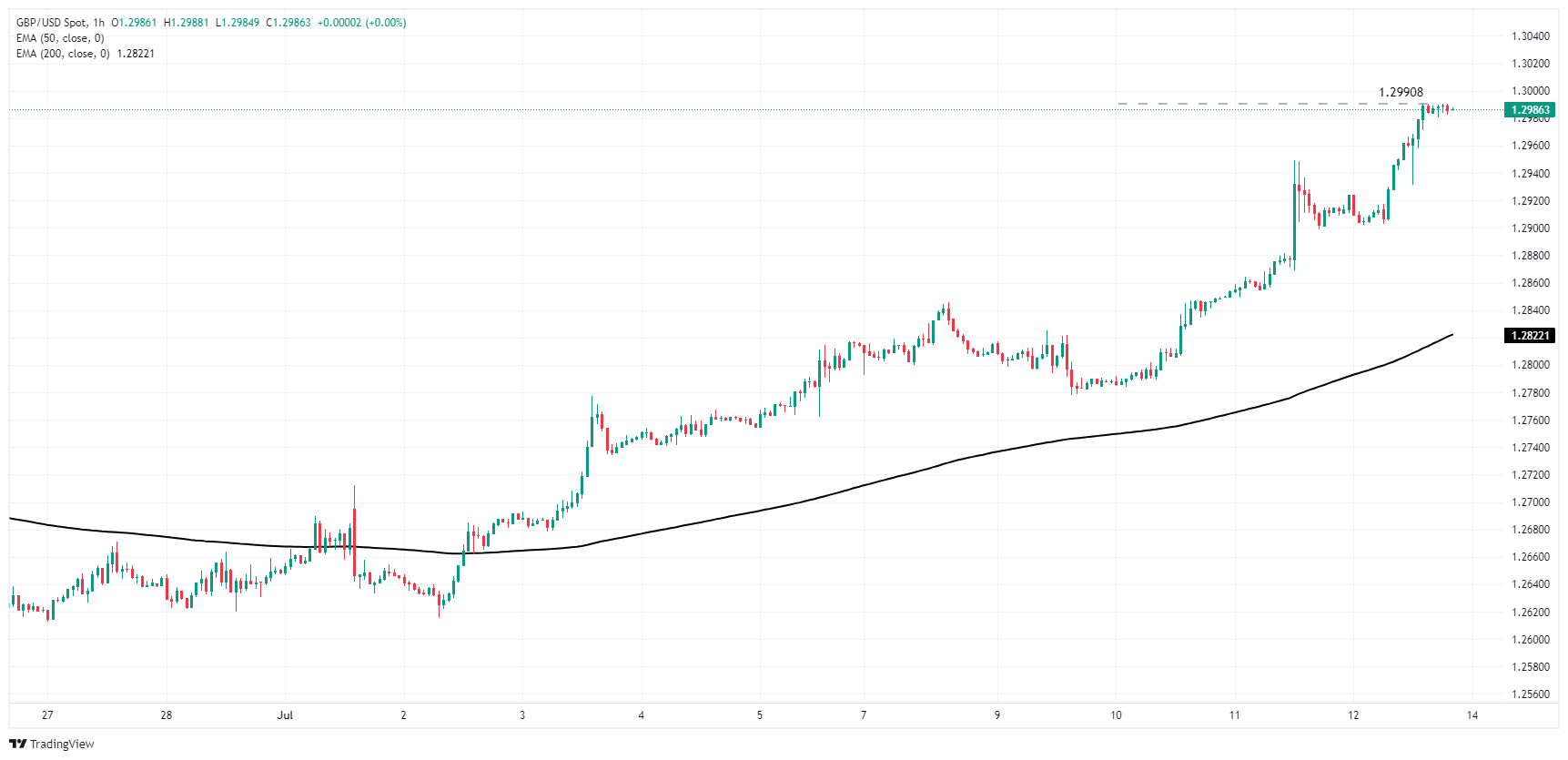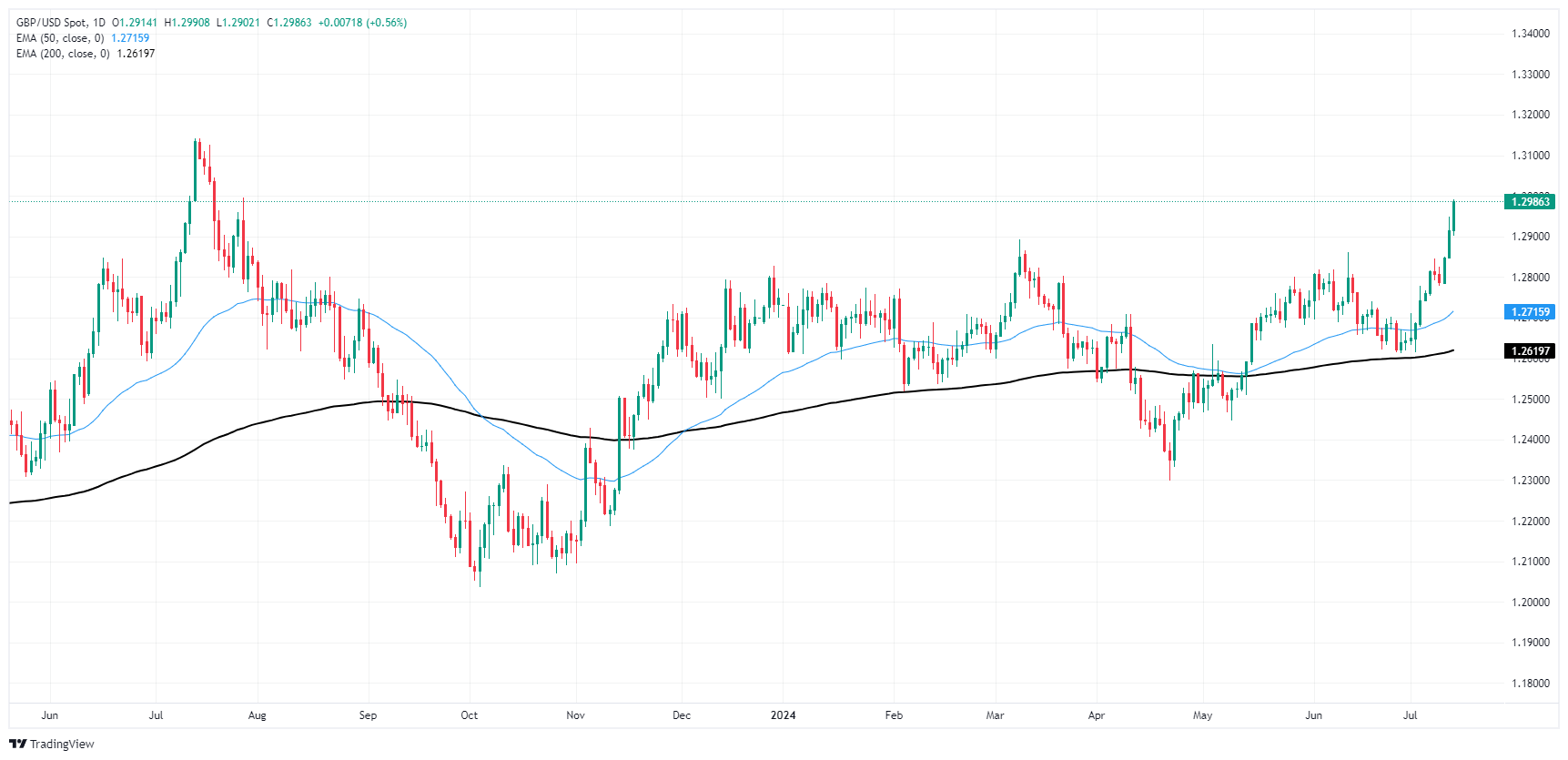- Analytics
- News and Tools
- Market News
- GBP/USD rises to 12-month high on Friday as markets pile into rate cut hopes
GBP/USD rises to 12-month high on Friday as markets pile into rate cut hopes
- GBP/USD approaches 1.3900 for the first time in a year.
- US PPI producer-level inflation rose faster than expected in June.
- Despite inflation risks, markets have pinned hopes on a September rate cut.
GBP/USD wrapped up Friday on the high side of a two-week rally as the US Dollar broadly buckles under the weight of investors dog-piling into hopes of getting a rate cut from the Federal Reserve (Fed) in September. Markets are shrugging off an unexpected uptick in Producer Price Index (PPI) wholesale inflation, which accelerated faster than expected in June and could put pressure on key Fed inflation metrics looking forward.
Forecasting the Coming Week: Fed rate cut bets and the ECB should rule the sentiment
In June, the core Producer Price Index (PPI) for wholesale inflation in the US accelerated to 3.0% year-over-year, exceeding the expected 2.5%. Additionally, the previous period's figure was revised upward to 2.6% from the initial 2.3%. Despite the significant increase in producer-level inflation, the market's attention has turned to the decrease in Consumer Price Index (CPI) inflation earlier in the week, leading to heightened expectations of a rate cut.
According to the CME's FedWatch tool, there is a significant probability of a quarter-point rate cut at the Federal Open Market Committee's (FOMC) meeting on September 18. Rate traders are also currently pricing in at least three rate cuts in total for 2024, which is more than the one or two cuts projected by the Fed by December.
Economic Indicator
Producer Price Index ex Food & Energy (YoY)
The Producer Price Index ex Food & energy released by the Bureau of Labor statistics, Department of Labor measures the average changes in prices in primary markets of the US by producers of commodities in all states of processing. Those volatile products such as food and energy are excluded in order to capture an accurate calculation. Generally speaking, a high reading is seen as positive (or bullish) for the USD, whereas a low reading is seen as negative (or bearish).
Read more.Last release: Fri Jul 12, 2024 12:30
Frequency: Monthly
Actual: 3%
Consensus: 2.5%
Previous: 2.3%
Source: US Bureau of Labor Statistics
In other US economic data released on Friday, the University of Michigan's Consumer Sentiment Index survey dropped to a seven-month low of 66.0, falling short of the expected increase to 68.5. This reflects increasing discouragement among US consumers about the economic outlook. Additionally, the University of Michigan's 5-year Consumer Inflation Expectations decreased slightly in July to 2.9% from the previous 3.0%. It's worth noting that long-term consumer inflation expectations remain significantly higher than the Fed's target annual inflation rate of 2.0%.
Coming up next week, the Sterling will face down the UK’s own Consumer Price Index (CPI) inflation release, slated for next Wednesday. UK labor data and Retail Sales will follow up in the back half of the week, and on the Greenback side, US Retail Sales will drop earlier in the week on Tuesday.
British Pound PRICE This week
The table below shows the percentage change of British Pound (GBP) against listed major currencies this week. British Pound was the strongest against the New Zealand Dollar.
| USD | EUR | GBP | JPY | CAD | AUD | NZD | CHF | |
|---|---|---|---|---|---|---|---|---|
| USD | -0.61% | -1.32% | -1.78% | -0.07% | -0.50% | 0.31% | -0.19% | |
| EUR | 0.61% | -0.52% | -0.86% | 0.86% | 0.27% | 1.27% | 0.77% | |
| GBP | 1.32% | 0.52% | -0.37% | 1.41% | 0.79% | 1.79% | 1.30% | |
| JPY | 1.78% | 0.86% | 0.37% | 1.74% | 1.32% | 2.29% | 1.68% | |
| CAD | 0.07% | -0.86% | -1.41% | -1.74% | -0.48% | 0.38% | -0.09% | |
| AUD | 0.50% | -0.27% | -0.79% | -1.32% | 0.48% | 1.00% | 0.50% | |
| NZD | -0.31% | -1.27% | -1.79% | -2.29% | -0.38% | -1.00% | -0.49% | |
| CHF | 0.19% | -0.77% | -1.30% | -1.68% | 0.09% | -0.50% | 0.49% |
The heat map shows percentage changes of major currencies against each other. The base currency is picked from the left column, while the quote currency is picked from the top row. For example, if you pick the British Pound from the left column and move along the horizontal line to the US Dollar, the percentage change displayed in the box will represent GBP (base)/USD (quote).
GBP/USD technical outlook
Cable rallied back into 12-month highs on Friday, extending into a second straight week of firm gains and inching back toward the 1.3000 handle. GBP/USD has risen nearly 3% in July, climbing from the month’s early swing low to 1.2615.
GBP/USD has closed in the green for all but two of the last twelve consecutive trading days as the pair vaults upwards from the 200-day Exponential Moving Average (EMA) at 1.2620. Bulls will be looking to drag bids into 2023’s peak of 1.3142, while bearish pressure will be looking to drag price action back to the 50-day EMA at 1.2715.
GBP/USD hourly chart
GBP/USD daily chart
Pound Sterling FAQs
The Pound Sterling (GBP) is the oldest currency in the world (886 AD) and the official currency of the United Kingdom. It is the fourth most traded unit for foreign exchange (FX) in the world, accounting for 12% of all transactions, averaging $630 billion a day, according to 2022 data. Its key trading pairs are GBP/USD, aka ‘Cable’, which accounts for 11% of FX, GBP/JPY, or the ‘Dragon’ as it is known by traders (3%), and EUR/GBP (2%). The Pound Sterling is issued by the Bank of England (BoE).
The single most important factor influencing the value of the Pound Sterling is monetary policy decided by the Bank of England. The BoE bases its decisions on whether it has achieved its primary goal of “price stability” – a steady inflation rate of around 2%. Its primary tool for achieving this is the adjustment of interest rates. When inflation is too high, the BoE will try to rein it in by raising interest rates, making it more expensive for people and businesses to access credit. This is generally positive for GBP, as higher interest rates make the UK a more attractive place for global investors to park their money. When inflation falls too low it is a sign economic growth is slowing. In this scenario, the BoE will consider lowering interest rates to cheapen credit so businesses will borrow more to invest in growth-generating projects.
Data releases gauge the health of the economy and can impact the value of the Pound Sterling. Indicators such as GDP, Manufacturing and Services PMIs, and employment can all influence the direction of the GBP. A strong economy is good for Sterling. Not only does it attract more foreign investment but it may encourage the BoE to put up interest rates, which will directly strengthen GBP. Otherwise, if economic data is weak, the Pound Sterling is likely to fall.
Another significant data release for the Pound Sterling is the Trade Balance. This indicator measures the difference between what a country earns from its exports and what it spends on imports over a given period. If a country produces highly sought-after exports, its currency will benefit purely from the extra demand created from foreign buyers seeking to purchase these goods. Therefore, a positive net Trade Balance strengthens a currency and vice versa for a negative balance.
© 2000-2025. All rights reserved.
This site is managed by Teletrade D.J. LLC 2351 LLC 2022 (Euro House, Richmond Hill Road, Kingstown, VC0100, St. Vincent and the Grenadines).
The information on this website is for informational purposes only and does not constitute any investment advice.
The company does not serve or provide services to customers who are residents of the US, Canada, Iran, The Democratic People's Republic of Korea, Yemen and FATF blacklisted countries.
Making transactions on financial markets with marginal financial instruments opens up wide possibilities and allows investors who are willing to take risks to earn high profits, carrying a potentially high risk of losses at the same time. Therefore you should responsibly approach the issue of choosing the appropriate investment strategy, taking the available resources into account, before starting trading.
Use of the information: full or partial use of materials from this website must always be referenced to TeleTrade as the source of information. Use of the materials on the Internet must be accompanied by a hyperlink to teletrade.org. Automatic import of materials and information from this website is prohibited.
Please contact our PR department if you have any questions or need assistance at pr@teletrade.global.















